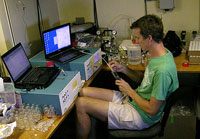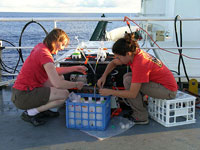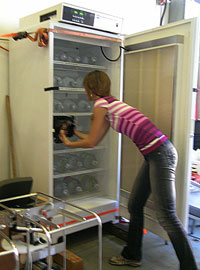- C-MORE Home
- What is Microbial Oceanography?
- What is C-MORE?
- Research
- • Research Cruises
- » BioLINCS
- Home
- Cruise Participants
- Instruments Used
on the Cruise - Nitrogen Cycling
- Marine Microbes
- Cruise Blog
- Data Archive
- Education & Outreach
- People
- Publications
- Image Library
- Contact Us
| |||||||||||||||||||||||||||||||||||
BioLINCS Cruise Blog
Wednesday, September 14, 2011
|
Julie Robidart (left) and Kendra Turk-Kubo (right) check the oxygen concentrations in bags of seawater that they are incubating on the upper deck of the Kilo Moana. |
|
Sam Wilson measures nitrogen gas concentrations in seawater from his incubation chambers. This helps him tell how much nitrogen gas the microbes are “fixing” (transforming to more biologically useful compounds). |
|
Every four hours, Elizabeth Ottesen (left) and Jessica Bryant (right) collect small amounts of seawater from their incubation experiments, to study how marine microbes process nitrogen at different times of day (and night). |
|
Daniela del Valle incubates microbes inside this large temperature-controlled incubator. She keeps her samples out of the light, because she is studying microbes that convert ammonium to nitrite, a process that may be slowed down by exposure to light. |
|
Researchers and marine operations technicians prepare to deploy an Incubating Productivity System (IPS) at sunset. |
In yesterday’s blog, I described how a lot of the seawater we bring up from the depths ends up being used for chemical analysis and filtered by the researchers to extract microbes. Another major use of this water is for “incubation experiments,” during which researchers allow the microbes in the seawater to grow for various amounts of time, and under various controlled conditions. In today’s blog I’ll describe a few of the incubation experiments that are being conducted on board the Kilo Moana.
On the upper deck of the ship are several transparent acrylic tanks, maybe two feet high and four feet square. They look like large aquaria, except that their walls and lids are tinted various shades of blue. When the tanks are in use, water is continually pumped through them from the ship’s seawater plumbing system.
Floating in these colored tanks are large plastic bottles and plastic bags filled with seawater, which contain the microbes that we are incubating. The idea is that the water in the bottles and bags is kept at the temperature of the surrounding ocean, while being exposed to natural cycles of sunlight and darkness. The different shades of blue simulate the different colors and amounts of sunlight that are available at different depths below the ocean surface.
At the moment, several of these incubation tanks contain a number of large, sealed plastic bags, which are part of an incubation experiment being carried out by Julie Robidart and Kendra Turk-Kubo. The plastic bags contain mixtures of seawater from near the surface and seawater from 130 meters below the surface. All of this water was collected using the ship’s CTD array.
The water from deeper CTD samples has been filtered to remove most of the living organisms. However, it still contains relatively large amounts of nutrients, such as nitrate, phosphate, and iron. The water from the shallow samples presumably contains lots of photosynthetic microbes, but is naturally very low in nutrients.
The point of this experiment is to simulate how microbes respond when deep water is carried up toward the surface. This sometimes happens near open-ocean eddies or during storms at sea. If the deep water carries lots of nutrients up toward the surface, these nutrients can act as “fertilizer” for microbes, allowing certain types of microbes to grow more rapidly than others.
After incubating their mixed water samples for a few days, Julie and Kendra will measure the amounts of nutrients in the water (they will also know how much nutrients were in each water sample to start with, thanks to the analytical chemistry work of Mariona Segura). They may also analyze the types of microbes that grew in their water samples, using the influx flow cytometer (IFC).
However, the main goal of Julie and Kendra’s incubation experiment is provide material for RNA analysis. Most of the water from each bag will be filtered and preserved at sea. Back on shore, the researchers will extract the RNA from the filters and run it through a “high-density microarray.” This will allow them to determine if their samples contain any of hundreds of thousands of different gene sequences from a wide variety of marine microbes. Such gene sequences may be associated with specific types of marine microbes or with enzymes such as “nitrogenase,” which is used in the process of nitrogen fixation.
Sam Wilson also has microbes incubating on the upper deck. These microbes were collected in water samples from CTD casts 25 meters below the surface. Every four hours or so, Sam removes a little water from his incubation chambers and measures the amount of nitrogen gas in this water. He is doing this to compare the amount of nitrogen being “fixed” (converted to ammonium) by microbes during the day time with the amount of nitrogen being fixed at night.
Some microbes (including our old friend Trichodesmium) fix nitrogen during the daytime, but others can only do this at night. So far, Sam has seen roughly equal amounts of nitrogen fixation during day and night. This contrasts with previous experiments, which showed much more nitrogen fixation during the day time.
Across the up deck from Sam and Julie’s experiments, Elizabeth Ottesen and Jessica Bryant have their own incubation tank, which they brought with them from MIT. Their tank also contains flow-through seawater for cooling, along with six plastic carboys for incubating microbes. They are performing similar incubations as Sam, collecting seawater from various depths and incubating the microbes in this seawater for 48 hours, while removing small amounts of water (and microbes) every four hours, around the clock.
The water samples from Elizabeth and Jessica’s experiment are being filtered and then preserved for later analyses back at MIT. They are particularly interested in studying the RNA of entire communities of microbes to figure out which genes are being used at different times of day. This type of cutting-edge analysis is known as “community transcriptomics.”
Another researcher, Daniella del Valle, is not cultivating microbes in natural sunlight, but in an enclosed incubator, which looks like a large refrigerator. This allows Daniella to control the temperatures and light levels experienced by the microbes. Daniella is taking samples of seawater from 130 meters below the surface and trying to cultivate the microbes that convert ammonium to nitrate—a process called “nitrification.” Nitrification is a multi-step process involving several groups of microbes. But two of the most important microbes are ammonium-oxidizing bacteria (AOB) and ammonium-oxidizing archaea (AOA). Archaea look similar to bacteria, but are in an entirely different biological domain.
For this experiment, Daniella is incubating her microbes in the dark, because there is some evidence that light can inhibit the nitrification process. Daniella has added nutrients (urea, ammonia, and glutamic acid) to her samples, to find out what types of microbes are favored under different concentrations of nutrients. Previous experiments have suggested that the archaea may do better when nutrients are scarce, but the bacteria may get the upper hand when there are plenty of nutrients available. Daniella is looking for data to prove or disprove this hypothesis.
After four days, Daniella will remove her water samples from the incubator and analyze the genetic material in the samples to figure out under which conditions the archaea became most abundant.
You can see that there’s a whole lot of incubation going on here on the Kilo Moana. Many researchers are running back-to-back incubation experiments, each of which lasts one to four days. This helps explain why we need hundreds of liters of water each day from the CTD casts, to keep these experiments going.
Two other incubation experiments, however, do not need water from the CTD casts. These are Craig Taylor’s Incubating Productivity System (IPS) and his Submersible Incubation Device (SID) which I discussed in my Sept 8 blog entry. These incubators are programmed at the surface and automatically perform incubations underwater.
The IPS and the SID came out of the water yesterday, after a six-day deployment, and went back into the water at twilight this evening. John Waterbury and I watched these high-tech incubators being lowered into the water, we mused on how humans have been successfully incubating microbes for thousands of years, making everything from beer and wine to yoghurt, cheese, and sourdough bread. As an expert on cultivating marine microbes, John remarked that it’s always possible to grow some kind of microbes. The trick is growing just the ones you want.
[ Top of Page ]








